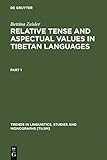Relative Tense and Aspectual Values in Tibetan Languages : A Comparative Study / Bettina Zeisler.
Material type: TextSeries: Trends in Linguistics. Studies and Monographs [TiLSM] ; 150Publisher: Berlin ; Boston : De Gruyter Mouton, [2011]Copyright date: ©2004Description: 1 online resource (986 p.)Content type:
TextSeries: Trends in Linguistics. Studies and Monographs [TiLSM] ; 150Publisher: Berlin ; Boston : De Gruyter Mouton, [2011]Copyright date: ©2004Description: 1 online resource (986 p.)Content type: - 9783110178685
- 9783110908183
- 490
- PL3623 .Z45 2004
- online - DeGruyter
- Issued also in print.
| Item type | Current library | Call number | URL | Status | Notes | Barcode | |
|---|---|---|---|---|---|---|---|
 eBook
eBook
|
Biblioteca "Angelicum" Pont. Univ. S.Tommaso d'Aquino Nuvola online | online - DeGruyter (Browse shelf(Opens below)) | Online access | Not for loan (Accesso limitato) | Accesso per gli utenti autorizzati / Access for authorized users | (dgr)9783110908183 |
Frontmatter -- Introduction -- Part I The concepts of TENSE, ASPECT, and MOOD (ΤΑΜ) -- 1 Markedness and meaning -- 2 Events and presentation of events in language -- 3 Some possible conceptualisations of events -- 4 Prototypes of ASPECT and FRAMING -- 5 Convergence: pragmatic functions of ΤΑΜ concepts -- 6 Interrelation and interaction: towards a delimitation of ΤΑΜ concepts -- Part II The Tibetan system of RELATIVE TENSE and aspectual values -- 1 General features of Tibetan languages -- 2 The Tibetan “verb” -- 3 Old and Classical Tibetan -- 4 Modern Tibetan – “Lhasa” dialect -- 5 East Tibetan: Amdo and Kham -- Part III West Tibetan (Ladakhi, Purik, Balti) -- 1 General features -- 2 The verb -- 3 The main temporal constructions -- 4 Narrative and other conventions -- 5 Conclusion: the set of oppositions in West Tibetan -- Part IV A comparative view -- 1 Some suggestions concerning the development of the verb stems -- 2 The development of the Modern Tibetan languages -- 3 Final conclusion -- Authors’ index (thematic) -- References
restricted access online access with authorization star
http://purl.org/coar/access_right/c_16ec
This study presents a comparative approach to a universal theory of TENSE, ASPECT and MOOD, combining the methods of comparative and historical linguistics, fieldwork, text linguistics, and philology. The parts of the book discuss and describe (i) the concepts of TENSE, ASPECT and MOOD; (ii) the Tibetan system of RELATIVE TENSE and aspectual values, with main sections on Old and Classical Tibetan, “Lhasa” Tibetan, and East Tibetan (Amdo and Kham); and (iii) West Tibetan (Ladakhi, Purik, Balti); Part (iv) presents the comparative view. Discussing the similarities and differences of temporal and aspectual concepts, the study rejects the general claim that ASPECT is a linguistic universal. A new linguistic concept, FRAMING, is introduced in order to account for the aspect-like conceptualisations found in, e.g., English. The concept of RELATIVE TENSE or taxis, may likewise not be universal. Among the Tibetan varieties, West Tibetan is unique in having fully grammaticalized the concept of ABSOLUTE TENSE. West Tibetan is compared diachronically with Old and Classical Tibetan (documented since the mid 8th century) and synchronically with several contemporary Tibetan varieties. The grammaticalized forms of each variety are described on the basis of their employment in discourse. The underlying general function of the Tibetan verbal system is thus shown to be that of RELATIVE TENSE. Secondary aspectual functions are described for restricted contexts. A special focus on the pragmatic or metaphorical use of present tense constructions in Tibetan leads to a typology of narrative conventions. The last part also offers some suggestions for the reconstruction of the Proto-Tibetan verb system.
Issued also in print.
Mode of access: Internet via World Wide Web.
In English.
Description based on online resource; title from PDF title page (publisher's Web site, viewed 28. Feb 2023)


